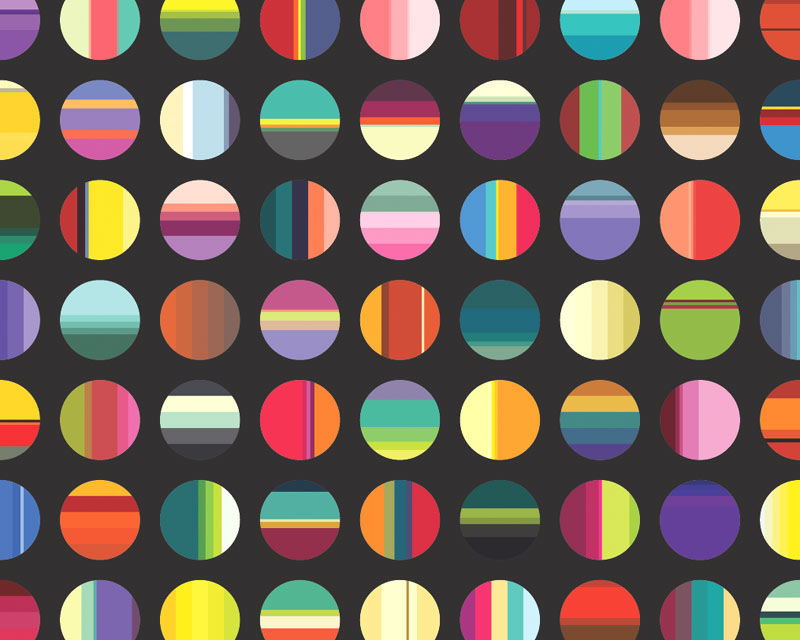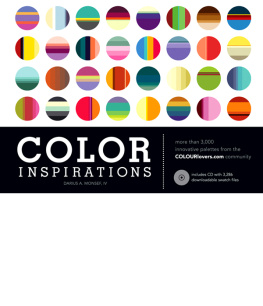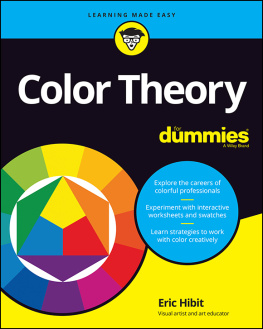DARIUS A. MONSEF, IV
Thank you for purchasing this How Design eBook.
Sign up for our newsletter and receive special offers, access to free content, and information on the latest new releases and must-have designing resources! Plus, receive a coupon code to use on your first purchase from MyDesignShop.com for signing up.
or visit us online to sign up at
http://howdesign.com/ebook-promo
COLOR INSPIRATIONS. Copyright 2011 by Darius A. Monsef, IV. Manufactured in China. All rights reserved. No other part of this book may be reproduced in any form or by any electronic or mechanical means including information storage and retrieval systems without permission in writing from the publisher, except by a reviewer, who may quote brief passages in a review. Published by HOW Books, an imprint of F+W Media, Inc., 4700 East Galbraith Road, Cincinnati, Ohio 45236. (800) 289-0963. First edition.
For more excellent books and resources for designers,
visit www.howdesign.com.
15 14 13 12 11 5 4 3 2 1
Distributed in Canada by Fraser Direct, 100 Armstrong Avenue, Georgetown, Ontario, Canada L7G 5S4, Tel: (905) 877-4411. Distributed in the U.K and Europe by F+W Media International, Brunel House, Newton Abbot, Devon, TQ12 4PU, England, Tel: (+44) 1626-323200, Fax: (+44) 1626-323319, E-mail: postmaster@davidandcharles.co.uk. Distributed in Australia by Capricorn Link, P.O. Box 704, Windsor, NSW 2756 Australia,
Tel: (02) 4577-3555.
Library of Congress Cataloging-in-Publication Data
Monsef, Darius A., IV.
Color Inspirations / Darius A. Monsef, IV.
pages cm
ISBN 978-1-60061-945-8 (hardcover : alk. paper)
1. Color decoration and ornament. 2. Color guides.
I. Title.
NK1548.M66 2011
701.85dc22
2010045533
 Edited by AMY OWEN
Edited by AMY OWEN
Designed by GRACE RING
Production coordinated by GREG NOCK
Dedicated to the creative, supportive and genuinely wonderful members of COLOURlovers.com.
About the Author
Darius, aka Bubs, is the founder and CEO of COLOURlovers.com and he wants the whole world to find color enlightenment. He built COLOURlovers after an uninspired class on color theory left him searching for an online community to explore color and share creative ideas. He never found it. So he built it. COLOURlovers now reaches more than one million creative individuals each month and has been recognized as an award-winning design resource and community. Darius is an Internet entrepreneur, writer, web designer/coder and former student of fashion design. Hes a creative and social media consultant and former community organizer for Microsofts Photosynth software. Hes also the co-founder of the disaster-relief nonprofit All Hands Volunteers (http://hands.org) and has spent more than a year living in disaster zones around the world.
About COLOURlovers.com
COLOURlovers.com is an international design community that helps creative folks around the world find inspiration and share their ideas with others. Reaching more than one million visitors each month, COLOURlovers is the largest color resource on the web. COLOURlovers has been nominated in the prestigious Webby Awards four years in a row (2007, 2008, 2009 & 2010) for Best Community. Starting as a simple service for sharing great colors and palettes, COLOURlovers has grown into a robust resource of more than 1.5 million palettes and 1.4 million seamless patterns and growing. The next brilliant color inspiration could be yours, and COLOURlovers wants to help you share it with the world.
TABLE OF CONTENTS

INTRODUCTION
THE RULES FOR COLOR ARE NOT BLACK AND WHITE
You shouldnt need to break rules: Make new ones. Play with color, try new things, be bold, be subtle, be creativeand be you. After all, youre a unique individual who sees the world like no one else does. Share that perspective and share your love of color.
We all have some common connections and associations to color based on cultural influences and popular theories, but color is ultimately a unique experience for all of us. And because of that, there is not just one set of rules for how to think about and use color.
We live in a global community with tools that allow us to create something independently and share it with the masses. This interconnected environment generates a much wider spectrum of color ideas and color applications.
When an artists work can reach people all over the world without leaving the easel, or a girl walking down the street can appear immediately on a blog in front of the next generation of fashion designers, it is clear that influence has become democratized. When an individual can have an impact on global trends, you no longer need to know what color the experts think you should use. You can share with everyone the colors you love.
This book isnt meant to be the answer to all your questions about color because you already hold the answers. It is the starting place for your creative color ideas. It is a source of color inspiration for you to begin your creative process.
I believe in color like I believe in spiritual enlightenment. It isnt something that can be given to you, but rather something that with the right teaching, information, inspiration and practice you can discover on your own. I hope this book helps you find a bit of color enlightenment that has meaning to you.
Weve organized the book into fifteen chapters of hues broken up by several color theories to help you navigate the more than 3,000 palettes collected here. To help stoke your creativity, there are also ten inspirational and informational color articles throughout the book.
Find your color enlightenment.
Darius,
Creator of COLOURlovers.com
Note: The CMYK color values in this book were converted from source RGB colors with an sRGB color profile to the CMYK color space with a U.S. Web Coated (SWOP) v2 color profile.
COLOR THEORY
THE BASICS OF COLOR
There is a basic problem in color theory, which was known to the early theorists, and that still remains today. It is that the color of light behaves differently than the color of pigment (paints, inks and dyes). These two behaviors have been named additive color and subtractive color, respectively. The basics we know today are rooted in the practical applications and physical models based on these two behaviors.
The First Theories
RYB
This subtractive theory was developed by observing the mixing properties of red, yellow and blue pigments. It was established that all known colors could be created by mixing these three colors but that those three colors themselves couldnt be created by mixing any other colors. This fundamental idea established color theory back in the eighteenth century and was documented in at least two books:










 Edited by AMY OWEN
Edited by AMY OWEN